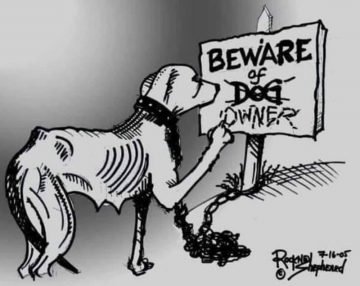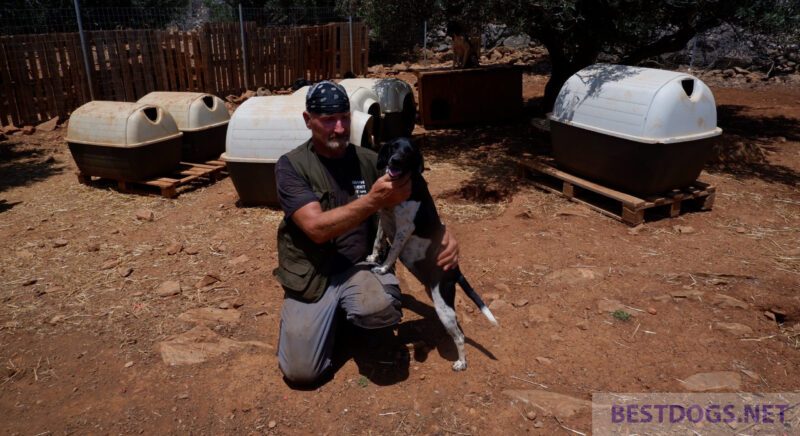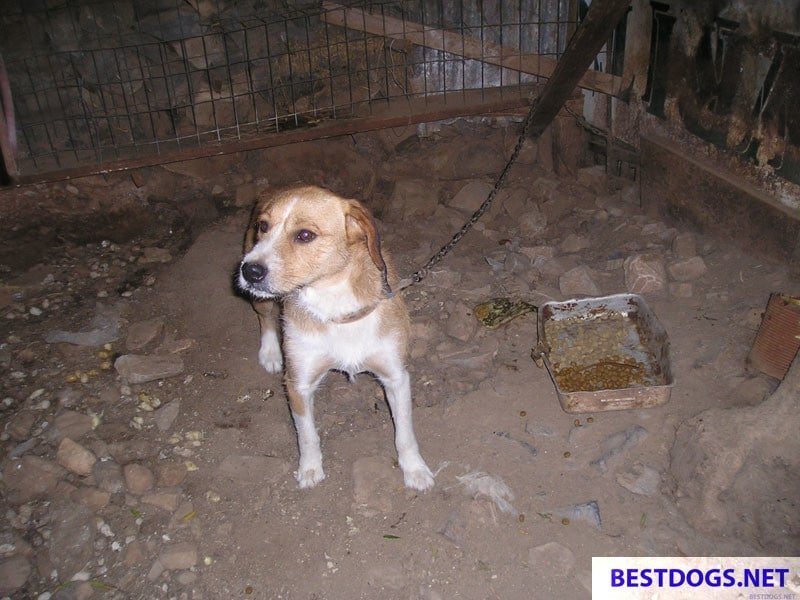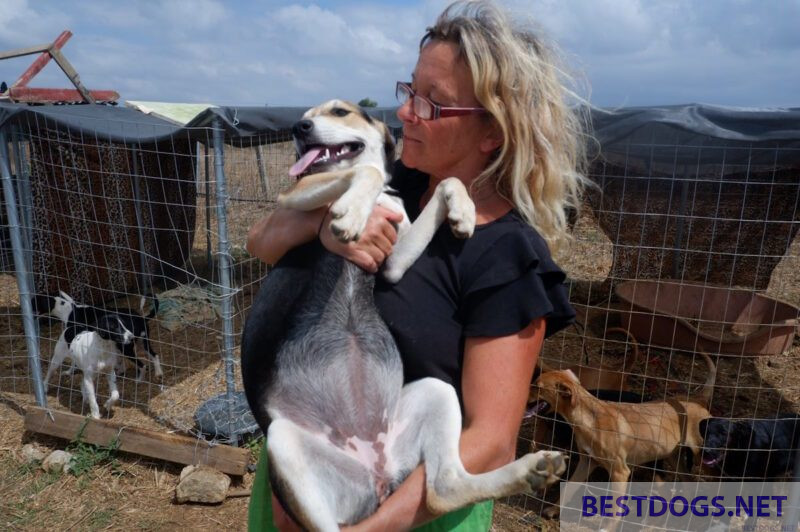Chaining and tying up dogs.
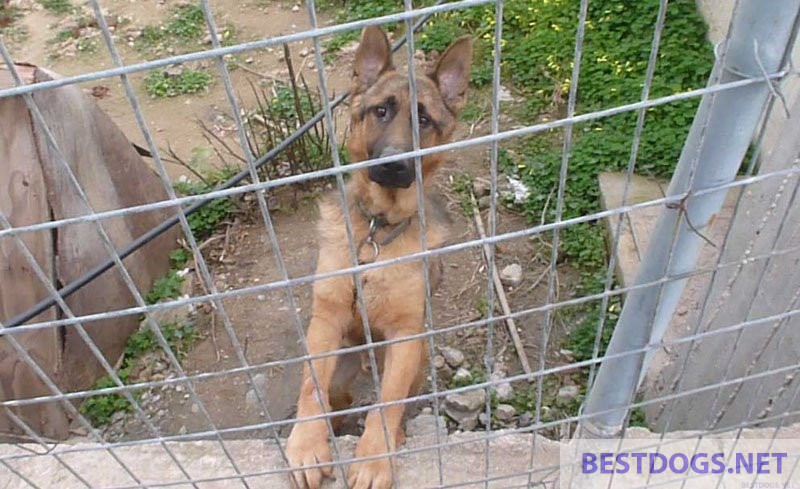
Causes and owners, the effects and dangers for the dogs involved and how to help them.
Meow Mix Original Choice Dry Cat Food, 6.3 Pound Bag
$8.99 (as of April 18, 2024 21:53 GMT +03:00 - More infoProduct prices and availability are accurate as of the date/time indicated and are subject to change. Any price and availability information displayed on [relevant Amazon Site(s), as applicable] at the time of purchase will apply to the purchase of this product.)Blue Buffalo Life Protection Formula Natural Adult Dry Dog Food, Chicken and Brown Rice 30-lb
$64.98 (as of April 18, 2024 21:54 GMT +03:00 - More infoProduct prices and availability are accurate as of the date/time indicated and are subject to change. Any price and availability information displayed on [relevant Amazon Site(s), as applicable] at the time of purchase will apply to the purchase of this product.)Advantage II Large Cat Vet-Recommended Flea Treatment & Prevention | Cats Over 9 lbs. | 6-Month Supply
$68.98 (as of April 18, 2024 21:53 GMT +03:00 - More infoProduct prices and availability are accurate as of the date/time indicated and are subject to change. Any price and availability information displayed on [relevant Amazon Site(s), as applicable] at the time of purchase will apply to the purchase of this product.)Chaining and tying dogs
Table of Contents
Definition
In general, the terms ‘chaining’ and ‘tethering’ refer to the practice of attaching a dog to a stationary object and leaving it unattended.
The term ‘chaining’ usually refers to situations where thick, heavy chains are used.
‘Tethering’ refers more to partially tethering to a rope, lighter chain or pulley, which is the more common form of tethering.
These terms do not refer to dogs that are on a leash or to instances where the owner is present and temporarily tethering the animal.
The owners of chained or tethered dogs
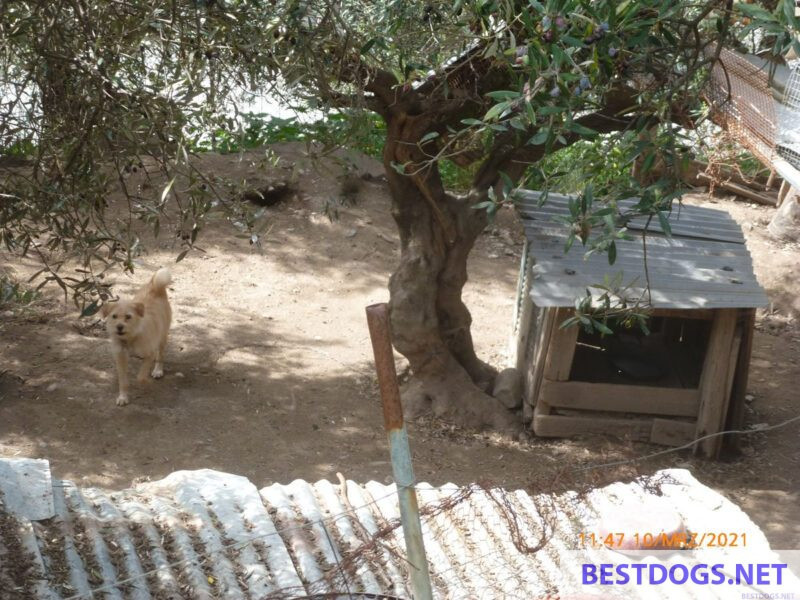
Owners tether their dogs for a variety of reasons. Most people who do so are unaware of the harm it can do to their dogs.
Social norms of pet ownership have made tethering unpopular in Western Europe, so it is declining as a practice, but in Greece, for example, it is still the most common way of keeping dogs.
Some of the reasons for this are:
The dog is a repeat escapee and the owner has run out of ideas to keep the dog safe. Sometimes this is why dogs are kept on heavier chains, because they have already chewed through or otherwise escaped lighter tethers, and the owner is trying to prevent them from getting away.
The owner is trying to protect their dog from something on the other side of the fence (children, another dog, etc.) by keeping the dog in a certain area of the yard.
The owner’s fence is damaged, or the owner does not have a fenced yard.
The dog’s behavior makes it difficult to keep it indoors, and the owner does not know how to correct the behavior.
The landlord may not allow the pet owner to keep the dog inside or put up a fence.
The pet owner comes from a family that has always tethered dogs and may not know there are better options.
Some owners abuse dogs simply to guard or deter their remote livestock enclosures, as with chickens, rabbits, and the like.
Also, for the guarding of remote and the night or the majority of the day empty buildings, preferably gladly aggressive guard dogs, are permanently chained there and receive up to more or less sufficiently good food and water mostly no run, attention and interaction. This is then a clear case of animal abuse.
Effects on tethered dogs
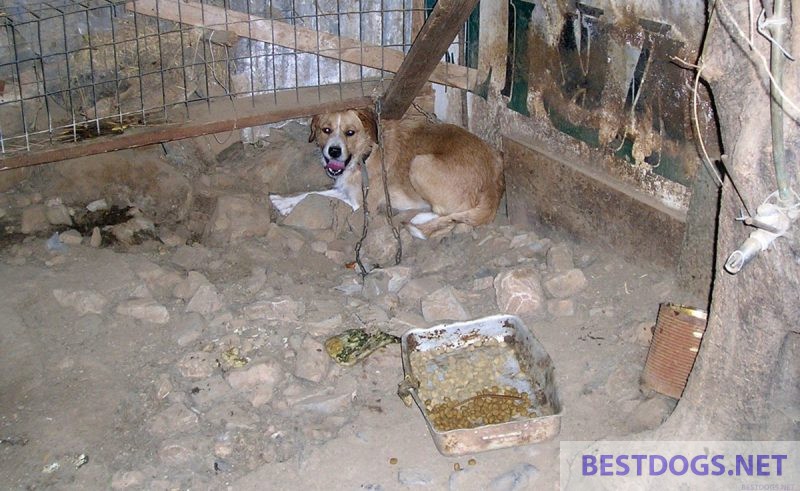
Dogs are naturally social creatures that need interaction with people or other animals. Intense confinement or long-term tethering can severely affect their physical and psychological well-being.
An otherwise friendly and docile dog will become neurotic, unhappy, fearful, and often aggressive if constantly chained or kept permanently confined in any way.
Without the freedom to roam, play and act out their natural behaviors, dogs kept on chains or leashes can become bored, lonely, depressed and often aggressive. Tethering confines a dog to a small area on the property and prevents it from roaming freely and interacting with other pets or people.
Many dog owners who keep their dogs chained are often unaware of the emotional and psychological damage they are doing, as they often do not check on their dogs often enough to realize this !
Many veterinarians agree that chains and tethers often cause neck and back injuries, and it’s even possible for a dog to hang itself if the chain gets caught on something high up.
They are susceptible to insect bites and parasites and are at high risk of entanglement, strangulation, and being harassed or attacked by other dogs or people.
Tethered dogs can also suffer from irregular feeding, overturned water bowls, inadequate veterinary care and extreme temperatures.
During snowstorms, these dogs often do not have access to shelter. During periods of extreme heat, they may not receive adequate water or shelter from the sun.
Owners who chain their dogs are less likely to clean the area where they are confined, resulting in dogs eating and sleeping in an area that is contaminated with urine and feces.
In addition, due to their often neurotic behavior, chained dogs rarely experience even a modicum of affection because it is difficult to get close to them. Chained dogs can thus simply be a ‘part of the scenery’ and are easily ignored by their owners.
Tethered dogs can be a danger

Tethering is not only bad for dogs, it is also at high risk for serious dog bites and attacks.
Dogs that are unable to retreat from perceived or actual threats may react aggressively when approached. Dogs that are tethered for extended periods of time can also become very aggressive.
Dogs naturally feel protective of their territory. When confronted with a perceived threat, they respond according to their instincts with fight or flight. A tethered dog, unable to flee, will attack any strange animal or person that unwittingly intrudes on its territory.
Tragically, the victims of such attacks are often children who approach the dog unaware of the dangers.
In addition, tethered dogs that eventually break free of their chains may remain aggressive and are likely to chase and attack unsuspecting passersby and pets, having developed severe behavioral problems from long, intense confinement.
Would you come back if you were tied up outside all alone ?
The same mental and emotional pain a human would experience from being chained is the same pain a dog experiences. As mentioned earlier, since chained dogs do not often have the opportunity to interact with people, they may not even know that they will be called back if you try to call them to you. Often, due to lack of adequate contact, these dogs do not even know their names.
It is important for people with tethered dogs to understand these risks.
Proper dog care
Dogs are considered a part of the family in the civilized world. Therefore, all dogs should live indoors, receive regular exercise, and be provided with adequate attention, food, water, and veterinary care.
Dogs that live partially or completely outdoors should be provided with a secure, escape-proof enclosure with adequate shelter where they can exercise their natural behaviors.
Tethering only in exceptions
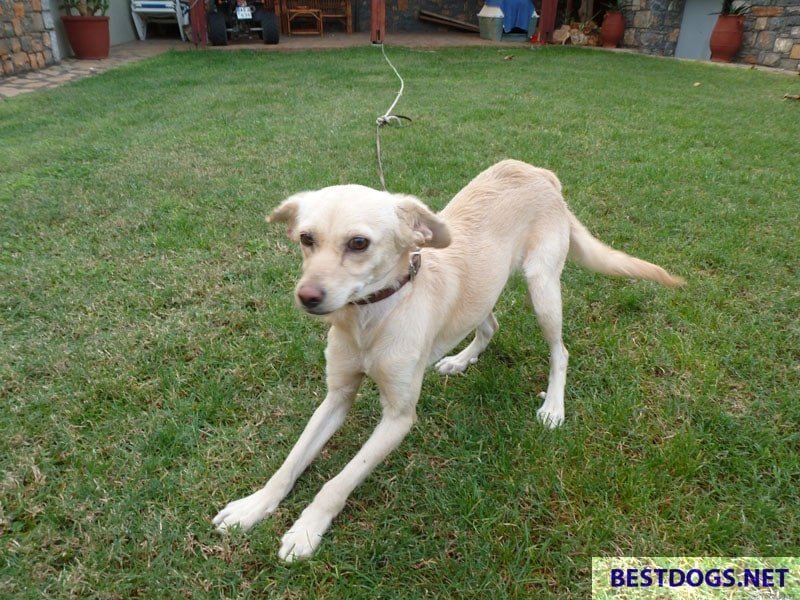
To become a well-adjusted companion animal, dogs should interact regularly with people and other animals and receive regular exercise.
Sometimes situations with tethered dogs can be gradually improved, such as bringing the dog indoors at least at night.
Tethering an animal may be acceptable if it is for a short period of time or under supervision, and if the leash is secured so that it cannot become entangled in other objects. It should also be avoided in ‘problem’ cases, such as excessive aggression, but which also mostly has its cause in permanent tethering, until an appropriate enclosure is provided.
Collars should be comfortable and properly fitted and choke chains should never be used. Tethering an animal for extended periods of time or during extreme weather conditions and natural disasters is not acceptable under any circumstances.
Tethering the dog with a pulley
Attaching a dog’s leash to a long line – such as a clothesline or a device known as a ‘pulley’ – and allowing the animal a larger area in which to move is preferable to tethering the dog to a stationary object.
However, many of the same risks associated with tethering still exist, including snagging and strangulation, attacks on or by other animals, lack of socialization and safety.
Help for tethered dogs
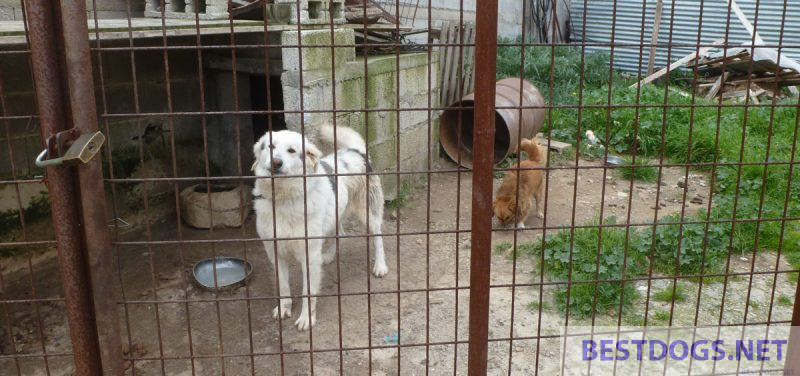
The first thing to do is to review the current legislation on tethering. If the local animal control agency is sufficiently well established and can effectively enforce the basic laws, tethering can be regulated locally.
If you are concerned about a particular dog that is tethered, consider asking the local animal control agency or police to pay the owner a visit.
Even if tethering is legal, staff can pay a friendly visit to see if they can improve the situation by helping the owner troubleshoot and gather information to get to the root of the problem. This relates to a behavior problem or repeated escapes.
Most situations can be improved through positive outreach and support services. Punitive measures can be used to address the most egregious situations.
Aside from enforcing the law, many communities benefit from a non-profit organization focused on reaching out to pet owners with pet care information, resources and services.
Attempting to crack down on dog chaining by ‘rescuing’ all tethered dogs is not advisable for a number of reasons.
First, many owners still care for and want to keep their dogs, and it is important that as many animals as possible remain in existing households.
Second, it is likely that the owner will replace the dog and continue to tether future dogs. Either because the dog serves a purpose for him or because he likes it anyway.
Removing the dog adds to the already overwhelming number of dogs competing for homes, further overburdening shelters and rescue organizations.
Working with owners to improve the situation for their existing dogs is always the best option, and experience shows that many people are open to support.
As opponents of chain dogs, it is important to find positive, constructive ways to empower owners to unchain their dogs themselves.
They are more likely to unchain their dogs, to unchain future dogs, and to tell others they know who may be chaining their dogs. This also conserves the valuable resources of non-profit animal welfare organizations or underfunded rescue agencies so they can focus on the serious cases of animal cruelty, abuse and neglect.
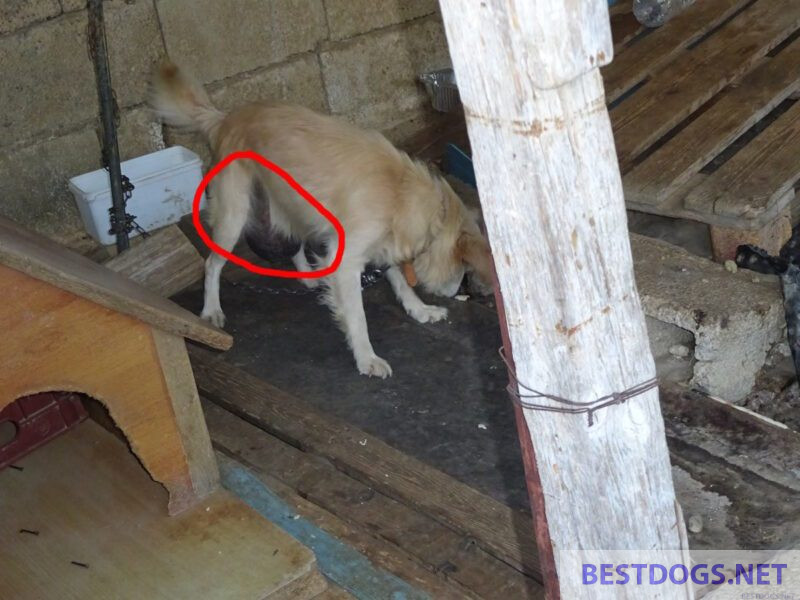
They will replace every dead, permanently tethered animal within a very short time by a new fellow sufferer and here the chain of suffering must be broken once and for all. This is usually only possible by threatening or carrying out a report for animal abuse.
Often it concerns here older persons, who do not know any other handling of animals – or humans, who are to be settled mostly in the lowest education level and are often also at the same time badly situated.
Here discussions often have little purpose and are partially also personally with dangers connected, whereby it already occurred that some of these owners threatened animal protectors even with the weapon.
For your own safety alone, it is better in these situations to report the case to the appropriate police authority.






